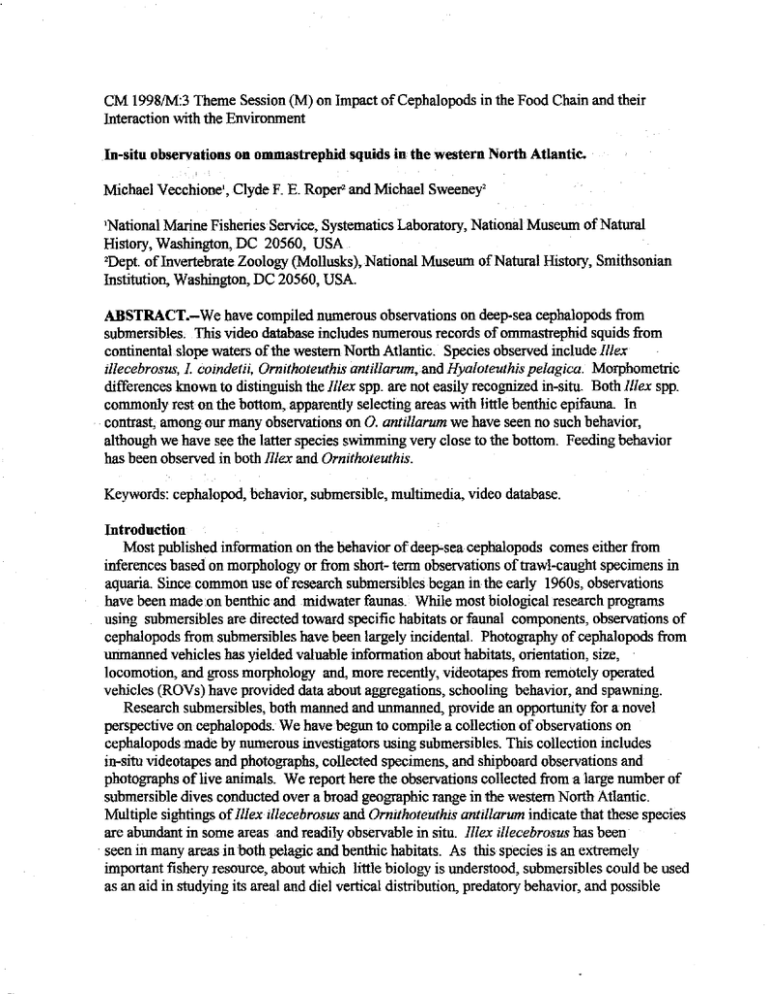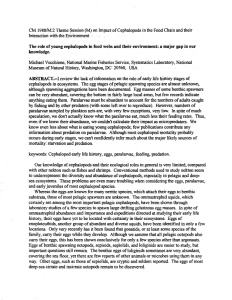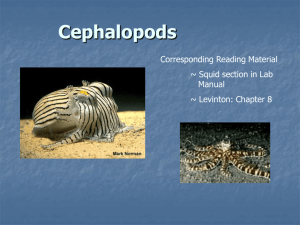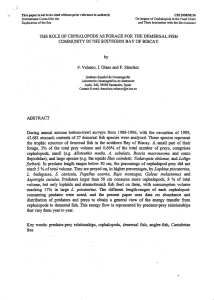CM 19981M:3 Theme Session (M) on Impact of Cephalopods in... Interaction with the Environment
advertisement

CM 19981M:3 Theme Session (M) on Impact of Cephalopods in the Food Chain and their
Interaction with the Environment
In-situ observations on ommastrephid squids in the western North Atlantic.
Michael Vecchione', Clyde F. E. Roper> and Michael Sweeney'
'National Marine Fisheries Service, Systematics Laboratory, National Museum of Natural
History, Washington, DC 20560, USA
'Dept. of Invertebrate Zoology (Mollusks), National Museum of Natural History, Smithsonian
Institution, Washington, DC 20560, USA.
ABSTRACT.-We have compiled numerous observations on deep-sea cephalopods from
submersibles. This video database includes numerous records of ommastrephid squids from
continental slope waters of the western North Atlantic. Species observed include IlIex
illecebrosus, 1. cOindetii, Omithoteuthis antillarum, and Hyaloteuthis pelagica. Morphometric
differences known to distinguish the IlIex spp. are not easily recognized in-situ. Both IlIex spp.
commonly rest on the bottom, apparently selecting areas with little benthic epifauna. In
contrast, among our many observations on 0. antillarum we have seen no such behavior,
although we have see the latter species swimming very close to the bottom. Feeding behavior
has been observed in both IlIex and Omithoteuthis.
Keywords: cephalopod, behavior, submersible, multimedia, video database.
Introduction
Most published information on the behavior ofdee!>"sea cephalopods comes either from
inferences based on morphology or from short- term observations of trawl -caught specimens in
aquaria. Since common use of research submersibles began in the early 1960s, observations
have been rnadeon benthic and midwater faunas. While most biological research programs
using submersibles are directed toward specific habitats or faunal components, observations of
cephalopods from submersibles have been largely incidental. Photography of cephalopods from
unmanned vehicles has yielded valuable information about habitats, orientation, size,
locomotion, and gross morphology and, more recently, videotapes from remotely operated
vehicles (ROVs) have provided data about aggregations, schooling behavior, and spawning.
Research submersibles, both manned and unmanned, provide an opportunity for a novel
perspective on cephalopods. We have begun to compile a collection of observations on
cephalopods made by numerous investigators using submersibles. This collection includes
in-situ videotapes and photographs, collected specimens, and shipboard observations and
photographs of live animals. We report here the observations collected from a large number of
submersible dives conducted over a broad geographic range in the western North Atlantic.
Multiple sightings of IlIex illecebrosus and Ornithoteuthis antillarum indicate that these species
are abundant in some areas ,and readily observable in situ. IlIex illecebrosus has been
seen in many areas in both pelagic and benthic habitats. As this species is an extremely
important fishery resource, about which little biology is understood, submersibles could be used
as an aid in studying its areal and diel vertical distribution, predatory behavior, and possible
spawning sites.
Materials and Methods
Observations presented here come from a variety of sources at various locations and depths.
Several investigations by personnel from Harbor Branch Oceanographic Institution have
supplied us with material. In the presentation thatfollows, an observation refers to a single
encounter with a cephalopod. Such an encounter may result in photographs, one or more
videotape sequences, a collected specimen,areliable description in the dive log, or any .
combination of these; all would be counted as a single observation. In some cases, a single
observation includes more than one cephalopod, such as a school of Illex.
Results
1. Illex illecebrQsus (LeSueur, 1821): 35 observations from Gulf of Maine and area of North
Carolina and South Carolina slope; 0930-2030 hours; depth observed, 180-890 m and depth
above bottom (where noted), 0-1000 m; no specimens collected.
2. Jllex cQ!ndetii (Verany, 1839): 10 observations (1 questionable ) from northern Gulf of'
Mexico; 1000-1700 hours; depth observed, 350-572 m and depth above bottom (where noted), 0I· m;.no specimens collected.
3. Illex sp.: 3 observations from Barbados and St. Lucia wall; 0830 hours; depth observed, 326412 m and depth above bottom (where noted), O-lm; 1 specimen collected.
4. Ommastrephes bartrami (LeSueur, 1821): 3 observations (1 questionable) from southern
FloridalBahamas; .1230-0030 hours; depth observed, 621-757 m, 1 specimen collected.
5. Ornithoteuthis antillarum Adam, 1957: 16 observations (1 questionable) from southern
FloridalBahamas;1000-0100 hours; depth observed, 457-878 m and depth above bottom {where
noted), 1-88 m; 7 specimens collected,
6. Hyaloteuthis pelagica (Bosc, 1802): 2 observations from southern FloridalBahamas;13000100 hours; depth observed, 510-686 m; no specimens collected.
Discussion.
These observations, based on videotapes recorded, previously for other purposes, allow us to
develop hypotheses about behavioral interactions between cephalopods and their milieu..
Behavioral observations are numerous and.unexpected, e.g., the "J-shaped" posture of several •
species, benthic resting by IllfiX spp.; feeding by Illexalonga vertical rock wall, and the ability
of Ornithoteuthis to bend its mantle. double to use the ventral arms for removal of irritants from
the fmsand tail. The important point is that these observations represent some ·of the first data
available on living ommastrephids in their natural environments. They allow us a glimpse,
however incomplete, into the lives and habits of these important members of marine ecosystems.






